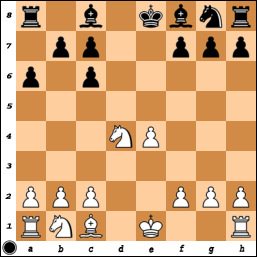Netherlands Team Championship 1923-4
1.e4 e5 2.Nf3 Nc6 3.c3 Nf6
Black's most popular reply to the Ponziani, but it scores much less well than the sharper 3...d5. However Speijer had played the latter against Euwe in their match two years earlier, losing a tactical battle that included opposite-side castling.
4.d4 d6!?
Not a particularly common choice, but it has been played by Smyslov and Tal.
5.d5!?
White does not get much from 5.dxe5 dxe5 6.Qxd8+ Nxd8 7.Nxe5 Nxe4, although White went on to win in Saveilly Tartakower - Lajos Steiner, Schlechter Memorial 1923. The main alternative to Euwe's move is 5.Bb5 Bd7 6.0-0, with what looks like a good Spanish.
5...Nb8
More popular is 5...Ne7, when Black can choose a King's Indian set-up with ...g6 and ...Bg7, or continue with …Ng6. However the text was Tigran Petrosian's choice in a win over Alexander Tolush at the 1957 Soviet Championship.
6.Bd3 Nbd7
Petrosian preferred 6...g6, while the main move has come to be 6...Be7.
7.h3!?
I presume this is prophylaxis against a pin by ...Bg4 after ...Nc5.
7...Nc5 8.Bc2 a5
Not 8...Ncxe4?? 9.Bxe4 Nxe4 10.Qa4+.
9.b4 Ncd7
9...Ncxe4!? is very sharp. One line given by Stockfish10 and Komodo10 runs 10.Qe2 Bf5 11.g4 Bg6 12.g5 Be7 13.gxf6 Nxf6, when the engines reckon Black has reasonable compensation for the piece.
10.0-0 g6 11.Be3 Bg7 12.Nbd2 0-0 13.Qc1 b6 14.Re1 Nh5 15.Nf1 Nf4 16.a3 Ba6 17.Qd2 Qe7 18.g3 Nh5 19.Bh6!?
This can be a controversial decision in this type of position. Black's king is weakened by losing its fianchettoed bishop, but White is giving up his better bishop.
19...Bxh6!?
Another controversial decision. There was a lot to be said for leaving White to make the exchange.
20.Qxh6 Qf6 21.Kg2 Qg7 22.Qd2 Bxf1+!?
Black's queenside light squares are weakened by this exchange, but the large number of pawns on the board favours knights, and Speijer may have had hopes of engineering a good-knight-v-bad-bishop ending.
23.Rxf1 f6 24.Qe2 Ra7 25.Qc4 Rc8 26.Rfb1 Nf8 27.Nd2 Rca8 28.Ba4 axb4 29.Bc6 bxc3 30.Bxa8 cxd2 31.Bc6
 |
| A tricky imbalance has arisen in which Black has a pair of knights and two pawns for rook and bishop. The engines reckon White is slightly better. Certainly the d2 pawn is unlikely to last long. |
A strange-looking move whose main purpose seems to be to give the f8 knight a square to go to. The engines suggest 32...Qg5 33.a4 f5 with what they reckon is a slight edge for White.
33.Qe2
There is no rush to take the d2 pawn - it cannot be saved.
33...Ng6 34.Qg4 Ng7
Stockfish10 gives 34...Ne7 35.Qe6+ Kf8 36.Bb5 Ng7 37.Qd7 f5 38.exf5 Ngxf5 39.a4 with a large advantage for White. Komodo10 suggests 34...f5!? 35.Qxf5 Nhf4+ 36.Kh2 (36.gxf4?? Nh4+) Ne7 37.Qg4 Nd3 38.Rxd2, when Black is a clear exchange down.
35.Rxd2 Ne7 36.Re2 f5 37.exf5 Qf6 38.a4 h5 39.Qc4 Ngxf5 40.a5?
The engines give 40.Rd1 Nxc6 41.Qxc6, when Black does not have enough for the exchange.
40...Nd4 41.Rb2 Qf3+ 42.Kg1 Qe4 43.Qc1 Nf3+ 44.Kf1 Nf5?
Black had a forced draw with 44...Nxc6 45.Qxc6 (or 45.dxc6) Nh2+ 46.Kg1 Nf3+ etc.
45.Qb1! Qc4+
The sequence 45...Nh2+ 46.Kf1 Nf3+ is no longer a draw because White has 47.Kh1, after which queens are coming off. If 45...Qxb1+, White has 46.Rbxb1! as 46...Nd2+ 47.Kg2 Nxb1 fails to 48.axb6! Rxa1 49.b7.
46.Kg2 N3d4 47.axb6?
The right idea, but the wrong execution. Correct is 47.Ra4 Qc3 and now 48.axb6, eg 48...Rxa4 49.bxc7 Ne7 50.c8=Q+ Nxc8 51.Qg6+ Kh8 52.Qe8+ Kg7 53.Rb7+ and mates.
47...Rxa1 48.Qxa1 Nxc6?
Black has drawing chances after 48...Qd3 and after 48...cxb6.
49.Qa8+ Kh7 50.Qxc6 Qe4+
Or 50...Qxc6 51.dxc6 cxb6 52.c7 Ne7 53.Rxb6 etc.
51.Kh2 Nd4
51...cxb6 52.Qd7+ Kg6 53.Rxb6 Qxd5 54.g4 etc.
52.Qxc7+ Kg8 53.Qc3 Nf3+ 54.Qxf3 Qxf3 55.b7 1-0
The Ponziani seems a good choice for tactical players. Euwe was far more than just a tactician, but he certainly out-calculated Speijer in this encounter.
















